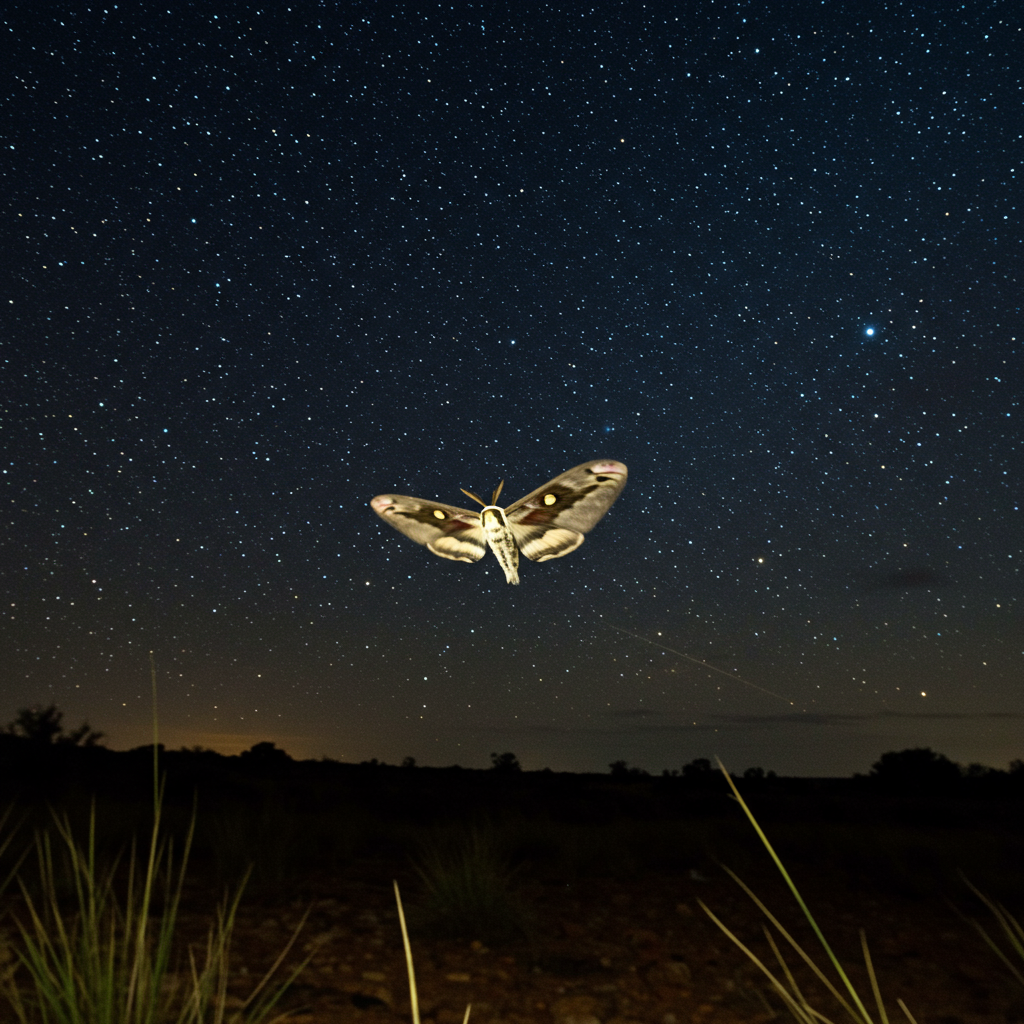The animal kingdom is full of incredible navigators, from birds soaring across continents to whales traversing oceans. But one group of often-overlooked creatures possesses a truly remarkable navigational skill: the humble moth. Specifically, scientists have discovered that Bogong moths, an Australian species, use the stars to find their way during epic, long-distance migrations.
This groundbreaking finding reveals a sophisticated ability previously known only in humans, birds, and possibly seals, marking Bogong moths as the first known invertebrates (animals without a backbone) confirmed to use the night sky for such extensive journeys.
The Epic Journey of the Bogong Moth
Each year, millions of Bogong moths (Agrotis infusa) undertake an astonishing migration across Australia. After emerging from their pupae, they fly hundreds, sometimes even a thousand kilometers, from warmer breeding grounds to cooler, specific caves high in the Australian Alps. These moths are navigating to locations they have never visited before, making their precision a long-standing scientific puzzle.
How do they manage this feat? Researchers have long suspected mechanisms like using the Earth’s magnetic field or following visual landmarks might play a role. However, the vast distances and navigation to precise points suggested something more was at work.
Cracking the Code: The Flight Simulator
To unravel this mystery, scientists conducted ingenious experiments. They tested the moths’ navigation abilities in a specialized “flight simulator” designed to recreate the conditions of the night sky while controlling other factors like the Earth’s magnetic field.
In these tests, researchers observed that when the simulated night sky displayed normal, predictable star patterns, the moths consistently attempted to fly in their correct migratory direction. However, when the artificial star patterns were randomized or scrambled, the moths became disoriented and lost their sense of direction. Recordings of the moths’ brain cells also showed responses linked to specific orientations of the simulated sky, providing neural evidence for their celestial compass.
A Dual Compass System
The research confirmed that Bogong moths possess not one, but two internal compasses for navigation. One relies on visual cues from the stars – their celestial compass. The other uses the Earth’s magnetic field – their electromagnetic compass. These two systems act as crucial fail-safes. On cloudy nights when the stars are hidden, they can rely on their magnetic sense. Conversely, during events like magnetic storms that might disrupt the magnetic field, they can switch to navigating by the stars.
This dual-system approach ensures they have a reliable way to stay on course regardless of environmental conditions during their arduous journey.
Remarkable Brains, Remarkable Journeys
The sophistication of this navigation system is particularly impressive considering the size of a moth’s brain – smaller than a grain of rice. Scientists have highlighted this as “remarkable,” noting that an animal with such a tiny brain can perform celestial navigation over hundreds of miles. While other insects like dung beetles use the Milky Way for short-distance orientation, Bogong moths demonstrate this skill on an entirely different scale.
This ability, previously thought to be restricted to animals with much larger brains and complex cognitive abilities, forces a rethink of how sophisticated navigation can evolve.
Beyond Bogongs: The Puzzle of Moths and Artificial Lights
While the Bogong moth uses distant celestial bodies for long-distance navigation, many people are more familiar with a different, seemingly contradictory moth behavior: flying erratically around artificial lights. This often leads to a common myth that moths are simply confused, mistaking porch lights for the moon or stars.
However, recent research offers a more nuanced explanation. Nocturnal insects like moths have evolved to use distant light sources like the moon and stars for orientation. Because these natural sources are incredibly far away, the light rays reaching the insect are effectively parallel. To fly in a straight line, a moth can simply maintain a constant angle between its body and the distant light source.
Unpacking the “Light Attraction” Myth
The problem arises with nearby, artificial point sources of light, like streetlights or lamps. When a moth tries to apply its natural navigation strategy – keeping the light source at a constant angle – to a nearby point source, it doesn’t fly straight. Instead, it spirals inwards towards the light. Its erratic flight around the bulb is a result of it constantly trying to reorient itself to a non-existent horizon created by the close light source. It’s not attraction to the light itself, but a malfunction of its celestial navigation system when faced with a close-proximity light.
The Impact of Our Lights on Night Navigators
This attraction to artificial lights has serious consequences for nocturnal insects. Light pollution, which now affects an estimated 23% of the world’s land area, is a significant contributor to global insect decline. Moths drawn to lights often spend the night fluttering around, exhausting themselves. It’s estimated that approximately one-third of insects attracted to artificial lights die by morning, preventing them from performing essential ecosystem roles like pollination and biocontrol, and crucially, from mating and reproducing.
The type of light matters, too. Moths are particularly sensitive to cooler, blue-spectrum lights. Warmer-colored LED lights (with a lower color temperature) are less attractive to many nocturnal insects compared to common cool white LEDs.
How You Can Help Our Night Navigators
Understanding how moths navigate by starlight and the negative impact of artificial lights offers ways we can help protect these fascinating creatures:
Turn off unnecessary outdoor lights: If you don’t need a light on, switch it off.
Use motion-activated lights: This provides security only when needed.
Close curtains at night: This prevents indoor light from spilling outside.
Choose warmer-colored bulbs: For necessary outdoor lighting, select bulbs with a lower color temperature (warmer tones) which are less disruptive.
- Shield lights downwards: Ensure outdoor lights only illuminate the area needed, reducing upward light scatter.
- www.vancouverisawesome.com
- www.rnz.co.nz
- www.thenakedscientists.com
By making small changes, we can reduce light pollution, helping nocturnal insects like the incredible Bogong moth continue their starlight-guided journeys and thrive in the night. Their ability to navigate by the stars is a powerful reminder of the hidden wonders of the natural world and the importance of preserving the darkness of our night skies.




